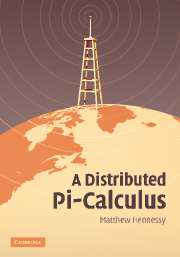2 - The asynchronous PI-CALCULUS
Published online by Cambridge University Press: 05 August 2012
Summary
Here we describe a simple language in which values are exchanged between concurrent processes via communication channels. These channels can be used to model resources and the syntax allows them to be declared as private, for the exclusive shared use of specific processes. The names of these channels/resources can also be transmitted between processes, resulting in a very powerful descriptive language.
We give two different views of the language. The first, via a reduction semantics, describes how processes may evolve. This may be seen as a specification of an interpreter for the language and is taken to be the primary semantic definition. The second view is an action semantics, which describes how processes can interact with other processes, perhaps as part of a larger system; this describes how processes can behave as part of a larger endeavour. This second view interprets the language as a labelled transition system or lts, as explained in Definition 1.2, and thus induces automatically a bisimulation equivalence between processes.
The language aPi
The syntax of the language aPi is given in Figure 2.1. It presupposes a set Names of names, ranged over by n,m, …, a, b, c … for communication channels or resources. We also use a set Vars of variables, place-holders for values that can be transmitted via the communication channels. These values will include some unspecified collection of base values such as integers, booleans, strings, etc., ranged over by bv, but more importantly channel names themselves.
- Type
- Chapter
- Information
- A Distributed Pi-Calculus , pp. 10 - 54Publisher: Cambridge University PressPrint publication year: 2007

